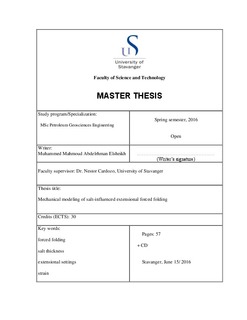| dc.contributor.author | Elsheikh, Muhammed | |
| dc.date.accessioned | 2016-10-12T14:47:03Z | |
| dc.date.available | 2016-10-12T14:47:03Z | |
| dc.date.issued | 2016-06-15 | |
| dc.identifier.uri | http://hdl.handle.net/11250/2414793 | |
| dc.description | Master's thesis in Petroleum geosciences engineering | nb_NO |
| dc.description.abstract | Scaled and numerical models show that the existence of an evaporite viscous layer (e.g. salt) facilitates the development of extensional forced folds related to basement normal faults. The geometries of the extensional forced folds and the resultant secondary faults are governed by several factors: the thickness and viscosity of the salt layer, the thickness, strength and ductility of the cover sediments, and the amount and rate of displacement on the sub-salt master normal fault. This research focuses on the effect of salt thickness and syn-sedimentation in order to reach a better understanding of the mechanical behavior of salt-influenced forced folding in extensional systems. Twelve 2D mechanical models are generated with three different basement fault dip angles (50°, 60° and 70°). Four models are run for each dip angle in which two of them are run without sedimentation while the other two include growth sediments. Furthermore, a thin and a thick salt layer are considered for each dip angle and syn-sedimentation case. Such modeling process allows us to compare the evolution and related structures of the 12 models. The workflow consists of discrete element modeling (DEM) to simulate normal faulting and forced folding, as well as the computation of total and incremental strain. The study shows that in the presence of a thick salt layer, the decoupling between sub- and supra-salt layers is effective (i.e. the salt efficiently decouples the basement from the overburden to far extent). For such setting a monocline develops within the cover sediment due to the displacement in the master fault. The forced fold quickly forms and secondary faults develop in the hanging-wall and more in the footwall block of the cover sequence. This geometry resembles an asymmetric triangular zone of faulting initiated at the tip of the basement fault and propagating upwards to the surface. Syn-sedimentation impacts the resultant structures by affecting the evolution of the geometry which is demonstrated by less secondary faults in the footwall and notable decrease in the deformation in the hanging-wall. Understanding the evolution of such faults and deformation styles is important and has wide implications for the exploration and production of hydrocarbons. | nb_NO |
| dc.language.iso | eng | nb_NO |
| dc.publisher | University of Stavanger, Norway | nb_NO |
| dc.relation.ispartofseries | Masteroppgave/UIS-TN-IPT/2016; | |
| dc.subject | petroleumsteknologi | nb_NO |
| dc.subject | petroleum engineering | nb_NO |
| dc.subject | petroleumsgeologi | nb_NO |
| dc.subject | petroleum geosciences engineering | nb_NO |
| dc.subject | forced folding | nb_NO |
| dc.subject | salt thickness | nb_NO |
| dc.title | Mechanical modeling of salt-influenced extensional forced folding | nb_NO |
| dc.type | Master thesis | nb_NO |
| dc.subject.nsi | VDP::Technology: 500::Rock and petroleum disciplines: 510::Geological engineering: 513 | nb_NO |
